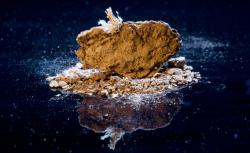Yesterday, the journal Science reported the discovery in an Oregon cave of human DNA that is more than 14,000 years old. The DNA was extracted from coprolites, or fossilized feces. They represent the oldest human remains found in the Western Hemisphere. Stone points discovered in the same cave differ from those used by the Clovis people, once thought to be the first North Americas. The findings suggest that a second group of people lived in the western United States at the same time, or possibly before, the Clovis culture. How do feces survive for more than 14,000 years?
They must be dumped in the right spot.
Broadly defined, fossils are remnants of life from more than 10,000 years ago. Most animal fossils fall into two categories: body fossils, like bone or tissue, and trace fossils like preserved footprints or fecal matter. Young fossils, like the ones found in Oregon, are usually just really dry bits of organic matter. Aerobic bacteria (bacteria that require oxygen) quickly break down wet organic matter; this makes a dry drop site crucial for the creation of young fossils.
The Paisley Caves, where the coprolites were found in south-central Oregon, are extraordinarily dry. This is a rare feature for caves. Most caves are moist from ground water, rain that seeps through cave openings, or snow that builds up at the mouth of the cave and then flows in when it melts. The fecal matter would have dried within a few days of being deposited in the Paisley Caves. The specimens likely sat on the cave floor for about 200 years before eventually becoming buried by dust and rocks that fell from the cave’s roof.
Older fossils, such as dinosaur bones, are usually formed when minerals replace the original organic matter, turning it to stone. Coprolites from dinosaurs come in this form. This process is helped along by anaerobic bacteria (bacteria that don’t require oxygen). In this case, depositing fecal matter in a lake is much more likely to lead to a fossil. Ideally, the feces will be excreted aquatically, sink to the bottom of the body of water and be immediately buried, depriving the specimen of oxygen. Anaerobic bacteria in the oxygen-poor environment will, over millions of years, replace the organic matter in the stool with phosphates and minerals.
Diet has little impact on the preservation of coprolites that are simply really dry pieces of stool. An analysis of the Oregon sample suggests that the cave dwellers were omnivores who ate a lot of roots, seeds, and nuts. Carnivores stand a much better chance of having their fecal matter fossilized into stone. Carnivores consume bones in their diet, which are already mineralized; this leaves less work for anaerobic bacteria once the stool is deposited.
This is the second time that coprolites have been discovered in the Paisley Caves. But even with the right conditions, the likelihood that a piece of fecal matter will turn into a fossil is extraordinarily small. Humans typically have from three bowel movements per week to three bowel movements per day, yet coprolites like those unearthed in Oregon, are rarely discovered.
Got a question about today’s news? Ask the Explainer.
Explainer thanks Anthony Martin of Emory University and Dennis Jenkins of the University of Oregon.
Video Explainer: Why is the NRA So Powerful?
This video was produced from an original Explainer by Brian Palmer.
Want more questions answered? You can now watch video Explainers at Slate’s News Channel on YouTube.
